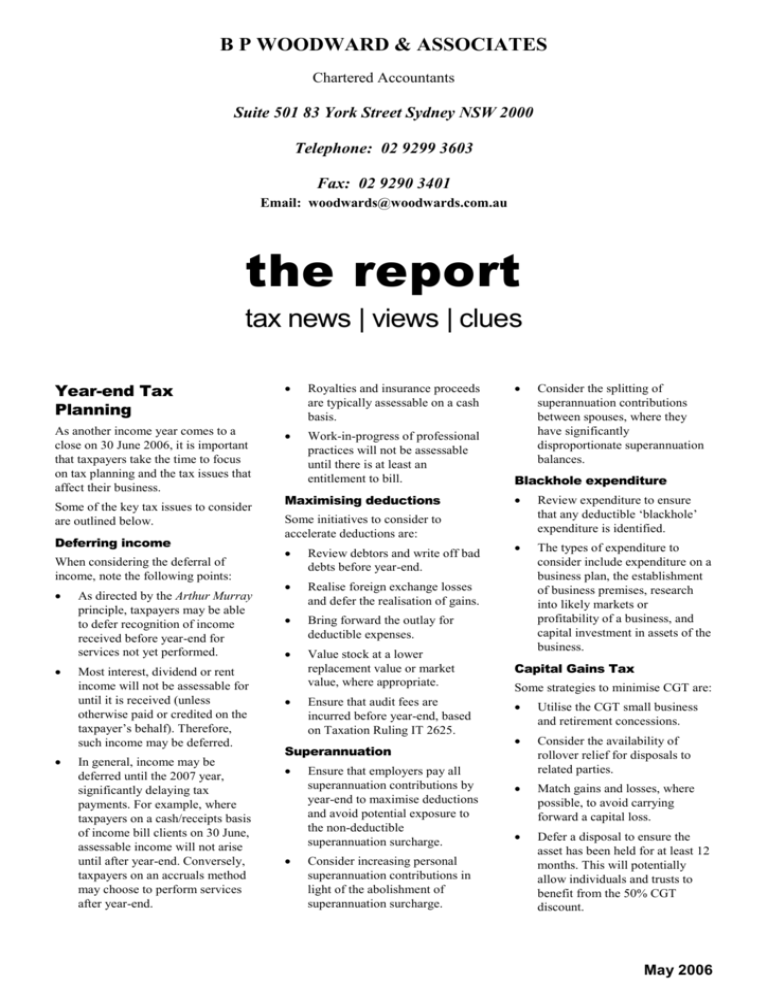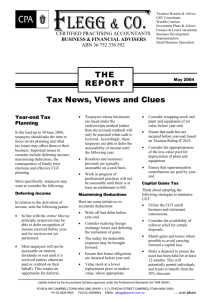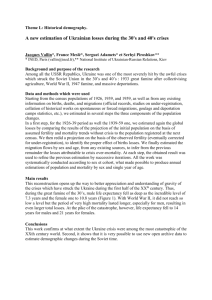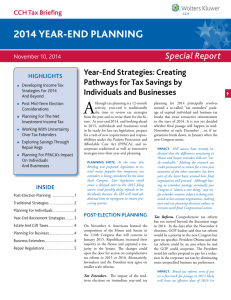Capital Gains Tax (CGT) Reform and Trusts
advertisement

B P WOODWARD & ASSOCIATES Chartered Accountants Suite 501 83 York Street Sydney NSW 2000 Telephone: 02 9299 3603 Fax: 02 9290 3401 Email: woodwards@woodwards.com.au the report tax news | views | clues Year-end Tax Planning Royalties and insurance proceeds are typically assessable on a cash basis. As another income year comes to a close on 30 June 2006, it is important that taxpayers take the time to focus on tax planning and the tax issues that affect their business. Work-in-progress of professional practices will not be assessable until there is at least an entitlement to bill. Some of the key tax issues to consider are outlined below. Deferring income When considering the deferral of income, note the following points: As directed by the Arthur Murray principle, taxpayers may be able to defer recognition of income received before year-end for services not yet performed. Most interest, dividend or rent income will not be assessable for until it is received (unless otherwise paid or credited on the taxpayer’s behalf). Therefore, such income may be deferred. In general, income may be deferred until the 2007 year, significantly delaying tax payments. For example, where taxpayers on a cash/receipts basis of income bill clients on 30 June, assessable income will not arise until after year-end. Conversely, taxpayers on an accruals method may choose to perform services after year-end. Maximising deductions Some initiatives to consider to accelerate deductions are: Review debtors and write off bad debts before year-end. Realise foreign exchange losses and defer the realisation of gains. Bring forward the outlay for deductible expenses. Value stock at a lower replacement value or market value, where appropriate. Ensure that audit fees are incurred before year-end, based on Taxation Ruling IT 2625. Superannuation Ensure that employers pay all superannuation contributions by year-end to maximise deductions and avoid potential exposure to the non-deductible superannuation surcharge. Consider increasing personal superannuation contributions in light of the abolishment of superannuation surcharge. Consider the splitting of superannuation contributions between spouses, where they have significantly disproportionate superannuation balances. Blackhole expenditure Review expenditure to ensure that any deductible ‘blackhole’ expenditure is identified. The types of expenditure to consider include expenditure on a business plan, the establishment of business premises, research into likely markets or profitability of a business, and capital investment in assets of the business. Capital Gains Tax Some strategies to minimise CGT are: Utilise the CGT small business and retirement concessions. Consider the availability of rollover relief for disposals to related parties. Match gains and losses, where possible, to avoid carrying forward a capital loss. Defer a disposal to ensure the asset has been held for at least 12 months. This will potentially allow individuals and trusts to benefit from the 50% CGT discount. May 2006 Review the cost base of assets to ensure all expenditure available under the expanded definition is included. Such expenditure includes, for example, certain selling costs, capital costs of ownership, and expenditure to preserve, move or install assets. Consider whether nondeductible costs may be included in an asset’s cost base including, for example, holding costs such as interest which are non-deductible. Consider whether it is most beneficial to utilise the 50% discount, where available, or frozen indexation. Defer a disposal to the subsequent income year where a gain is anticipated. Consider bringing forward a loss transaction if there are gains to offset. Remember that year-end trust distributions and income injections may affect a trust’s ability to recoup prior year tax losses and bad debt deductions. Where the trust has derived capital gains, consider the ATO’s Practice Statement in relation to the taxation of beneficiaries and the trustee on the trust income and capital and the different potential approaches available. Tax consolidation Consider whether an election to form a consolidated group should be made for tax purposes. If ACA is to be used, or if there are losses, consider whether valuations should be obtained as part of the consolidation process. Review the potential tax treatment of losses within company groups. In particular, consider whether tax losses should be best utilised within a consolidated group (subject to available fractions) or whether the group should remain unconsolidated. If a loss group consolidates, consider the potential impact of capital injections into the group, which may reduce access to losses. Trust distributions Make sure a trustee resolves to distribute the net income of the trust before 30 June 2006, or by 31 August 2006 (relying on Tax Office administrative concessions). Where individuals incur losses from business activities, the non-commercial loss rules should be considered because, under the rules, such losses may not be eligible for offset against other assessable income during the year. Where a private company provides loans to shareholders, a careful review of the loan arrangement must be undertaken, as certain rules may deem the loan to be an unfranked dividend. It may be necessary to ensure appropriate loan agreements are in place and repayments are made. Review any similar loans by trusts where a corporate beneficiary has an unpaid present entitlement to trust income. These loans can also result in deemed dividends. Where an individual applies personal efforts and skill in performing services to third parties through an interposed entity (e.g. a company), the personal services income rules may deem the individual to be assessable on the income generated. Careful consideration of such arrangements should be undertaken to avoid the application of the rules. Family trust elections Consider whether a family trust election should be made because of losses or bad debts in trusts. Ensure optimum utilisation of franking credits and consider making a family trust election where a trust holds shares acquired post-31 December 1997. Make sure no distributions are made outside the family group to avoid any potential liability for family trust distributions tax. Where a company is owned by discretionary trusts, there may be a need for family trust elections at the trust level if the company has losses. Elections may also be required to enable utilisation of franking credits as noted above. Simplified imputation Ensure all dividends paid within a franking period have been franked to the same extent. Ensure that there are adequate franking credits. Ensure a company paying a franked dividend has issued a distribution statement in the approved form. Other key issues Other important matters include the following: International Plan to utilise foreign tax credits against Australian tax on foreign income of the same class. Consider international related party transactions — whether arm’s length prices have been charged, and whether there are transfer pricing issues to address. Identify and address other international tax issues such as permanent establishments and controlled foreign companies. Consider the effective lives of depreciable assets. Important: This is not advice. Clients should not act solely on the basis of the material contained in this Bulletin. Items herein are general comments only and do not constitute or convey advice per se. Also changes in legislation may occur quickly. We therefore recommend that our formal advice be sought before acting in any of the areas. The Bulletin is issued as a helpful guide to clients and for their private information. Therefore it should be regarded as confidential and not be made available to any person without our prior approval.











